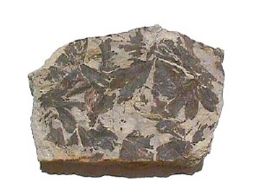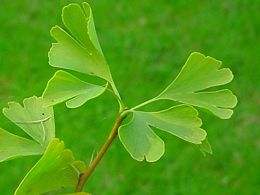Living fossil
Living fossil is an informal term for any living species (or clade) of organism which appears to be the same as a species otherwise only known from fossils and has no close living relatives. These species have all survived major extinction events, and generally retain low taxonomic diversities. A species which successfully radiates (forming many new species after a possible genetic bottleneck) has become too successful to be considered a "living fossil". However, the term is frequently misinterpreted.
Contents |
Overview
There is a subtle difference between a "living fossil" and a "Lazarus taxon". A Lazarus taxon is a taxon (either one species or a group of species) that suddenly reappears, either in the fossil record or in nature (i.e. as if the fossil had "come to life again"), while a living fossil is a species that (seemingly) hasn't changed during its very long lifetime (i.e. as if the fossil has always lived). The mean species turnover time (the time a species lasts before it is replaced) varies widely among the phyla, but averages about 2-3 million years. So, a living species that was thought to be extinct (e.g. the coelacanth, Latimeria chalumnae) is not a living fossil simply due to that definition (though it may still be one because it hasn't changed much), it is a Lazarus species. Coelacanths disappeared from the fossil record some 80 million years ago (upper Cretaceous). If, however, other Cenozoic Latimeria fossil species were to be found, the coelacanth would be considered a true living fossil, as that would fill in the gap where the species is "dead". Of course, species do not just appear out of thin air, so all living Lazarus species (excluding disappearing and reappearing red list species) are nonetheless considered living fossils, if it can be shown they are not Elvis taxa.
Some living fossils are species that were known from fossils before living representatives were discovered. The most famous examples of this are the coelacanthiform fishes Latimeria chalumnae and Latimeria menadoensis and the dawn redwood, Metasequoia, discovered in a remote Chinese valley. Others include glypheoid lobsters, mymarommatid wasps, and jurodid beetles, all of which were first described from fossils, but later found alive (2 species, 10 species, and one species respectively). Others are a single living species with no close living relatives, but which is the survivor of a large and widespread group in the fossil record, perhaps the best-known example of which is Ginkgo biloba (the ginkgo), though there are others, such as the Syntexis libocedrii (the cedar wood wasp).
Note that just because a living fossil is a surviving representative of an archaic lineage does not necessarily require that it retains all of the "primitive" features (plesiomorphies) of the lineage it is descended from; that is, they may possess one to many derived features (autapomorphies), that have evolved since the time of their lineage's divergence. All that is required is that they can be unambiguously assigned to an otherwise extinct lineage (rarely are they identical to the fossil forms). See for example the uniquely and highly autapomorphic oxpeckers, which are not "true" living fossils (as no fossils are known yet) but nonetheless appear to be the only survivors of an ancient lineage related to starlings and mockingbirds[1].


Note the similarity between the 170 million year old fossil Ginkgo sp. leaves on the left, and the living plant on the right.
Examples
Some of these are informally known as "living fossils".
Plants
- Amborellaceae
- Araucaria araucana the Monkey Puzzle tree
- Cycads
- Ginkgo tree (Ginkgoaceae)
- Horsetails Equisetum (Equisetaceae)
- Metasequoia Dawn Redwood (Cupressaceae; a borderline example, related to Sequoia and Sequoiadendron)
- Sciadopitys tree (Sciadopityaceae)
- Whisk ferns Psilotum (Psilotaceae)
- Welwitschia (Welwitschiaceae)
- Wollemia tree (Araucariaceae; a borderline example, related to Agathis and Araucaria)
Fungi
- Neolecta
Animals
- Vertebrates
- Mammals
- Cypriot mouse (Mus cypriacus)
- Red Panda (Ailurus fulgens)
- Okapi (Okapia johnstoni)
- Laotian Rock Rat (Laonastes aenigmamus)
- Volcano rabbit (Romerolagus diazi)
- Amami rabbit (Pentalagus furnessi)
- Iriomote cat (Prionailurus iriomotensis)
- Monito del Monte (Dromiciops gliroides)
- monotremes (the platypus and echidna)
- Mountain Beaver (Aplodontia rufa)
- Opossums
- Przewalski's Horse (Equus ferus przewalskii, Equus przewalskii or Equus caballus przewalskii, classification is debated)
- Birds
- Acanthisittidae (New Zealand "wrens")
- Hoatzin (Ophisthocomus hoazin)
- Broad-billed Sapayoa (Sapayoa aenigma)
- Bearded Reedling (Panurus biarmicus)
- Coliiformes (mousebirds, 6 living species in 2 genera)
- Magpie-goose (Anseranas semipalmata)
- Reptiles
- Pig-nosed turtle
- Crocodilia (crocodiles, gavials and alligators)
- Tuataras (Sphenodon punctatus and Sphenodon guntheri)
- Amphibians
- Purple frog (Nasikabatrachus sahyadrensis)
- Bony fish
- Bowfin (Amia calva)
- Coelacanth (the lobed-finned Latimeria menadoensis and Latimeria chalumnae)
- Queensland lungfish (Neoceratodus fosteri)
- Sturgeons and paddlefish (Acipenseriformes)
- Sharks
- Frilled shark (Chlamydoselachus anguineus)
- Mammals
- Invertebrates
- Insects
- Mantophasmatodea (gladiators; a few living species)
- Mymarommatid wasps (10 living species in genus Palaeomymar)
- Nevrorthidae (3 species-poor genera)
- Notiothauma reedi (a scorpionfly relative)
- Orussidae (parasitic wood wasps; about 70 living species in 16 genera)
- Peloridiidae (peloridiid bugs; fewer than 30 living species in 13 genera)
- Sikhotealinia zhiltzovae (a jurodid beetle)
- Syntexis libocedrii (Anaxyelidae cedar wood wasp)
- Crustaceans
- glypheoid lobsters (3 living species: Neoglyphea inopinata, N. neocaledonica, and Laurentaeglyphea neocaledonica)
- Triops cancriformis (a notostracid crustacean)
- Molluscs
- Nautilina (e.g. Nautilus pompilius)
- Neopilina galateae, a monoplacophorid mollusc
- Ennucula superba (Nut clam)
- Other invertebrates
- crinoids
- Horseshoe crabs (only 4 living species of the class Xiphosura, family Limulidae: Limulus polyphemus,Tachypleus gigas, Tachypleus tridentatus and Carcinoscorpius rotundicauda)
- Lingula anatina (an inarticulate brachiopod)
- onychophorans
- Valdiviathyris quenstedti (a craniforman brachiopod)
- Insects
History
The term was first coined by Charles Darwin in his The Origin of Species, when discussing Ornithorhynchus (the platypus) and Lepidosiren (the South American lungfish):
| “ | ... All fresh-water basins, taken together, make a small area compared with that of the sea or of the land; and, consequently, the competition between fresh-water productions will have been less severe than elsewhere; new forms will have been more slowly formed, and old forms more slowly exterminated. And it is in fresh water that we find seven genera of Ganoid fishes, remnants of a once preponderant order: and in fresh water we find some of the most anomalous forms now known in the world, as the Ornithorhynchus and Lepidosiren, which, like fossils, connect to a certain extent orders now widely separated in the natural scale. These anomalous forms may almost be called living fossils; they have endured to the present day, from having inhabited a confined area, and from having thus been exposed to less severe competition. | ” |
|
— Charles Darwin , The Origin of Species, p49
|
Other definitions
There are quite a lot of (ambiguous) definitions denoting living fossils:
- A living taxon that lived through a large portion of geologic time
- To prove this, all living specimens must belong to the same fossil species. This rules out Limulus, Peripatus, Latimeria, Sphenodon, Didelphis, the platypus, and many others. To allow some flexibility, the genus could be used. Paleontological taxonomy relies on hard-part morphology (the paleontological species concept), so there is a bias towards longer species turnover times, and relationships can only be inferred partially. Modern molecular biology has shown that genetic rates of change are relatively uniform and not well related to morphological change rates. So from a more molecular basis of interbreeding capabilities there are essentially no such thing as species that lived through a long geological time. However, with the proviso that we are using the special case of a paleontological species name, the definition does hold together in context. Queensland lungfish (Neoceratodus fosteri) is an example of an organism that meets this criteria, fossils identical to modern Queensland lungfish have been dated at over 100 million years making this species one of the oldest if not actually the oldest extant vertebrate species.
- A living taxon morphologically and/or physiologically resembling a fossil species through a large portion of geologic time (morphological stasis)
- The living specimens need not belong to the same fossil species (or even genus). There must at least be some physiological resemblance.
- The coelacanth for example, is a marine fish. The Mesozoic coelacanth species lived in salt and fresh water. Osmoregulation in Latimeria is handled by ureum retention. Ureum retention is considered to be an indication of fresh water ancestry. This means that the coelacanth lineage has evolved from freshwater to saltwater.
- The resemblance between Peripatus and Aysheaia (an early Cambrian animal from the Burgess Shale) is striking (as of now, both are classified in the Tardipolypoda (Tardigrada and Onychophora), were it not that Aysheaia was a marine animal, while Peripatus lives in tropical leaf mould.
- A living taxon with many primitive characteristics
- This is a more neutral definition. However, it does not make it clear whether the taxon is truly old, or it simply has many plesiomorphies. Note that, as mentioned above, the converse may hold for true living fossil taxa; that is, they may possess a great many derived features (autapomorphies), and not be particularly "primitive" in appearance.
- Any one of the above three definitions, but also with a relict distribution in refuges.
- Some paleontologists consider "living fossils" with large distributions (such as Triops cancriformis) not to be real living fossils. In the case of Triops cancriformis (living from the Triassic until now), the Triassic specimens have lost most of their appendages (mostly only carapaces remain), and they haven't been thoroughly examined since 1938.
- Any of the first three definitions, but the clade also has a low taxonomic diversity (low diversity lineages)
- Oxpeckers are morphologically somewhat similar to starlings due to shared plesiomorphies, but are uniquely adapted to feed on parasites and blood of large land mammals which has always obscured their relationships. This lineage forms part of a radiation that includes Sturnidae and Mimidae but appears to be the most ancient one of these groups. Biogeography strongly suggests that oxpeckers originated in eastern Asia and only later arrived in Africa, where they now have a relict distribution (Zuccon et al. 2007). The two living species thus seem to be representatives of an entirely extinct and (as Passerida go) rather ancient lineage, as certainly as this can be said in the absence of actual fossils. The latter is probably due to the fact that the oxpecker lineage never occurred in areas where conditions were good for fossilization of small bird bones, but of course, fossils of ancestral oxpeckers may one day turn up enabling to test this theory.
An organism's living fossil status can be rejected if the (smallest) clade the species belongs to is species rich, as this would imply (recent) speciation.
References
- ↑ Zuccon, Dario; Cibois, Anne; Pasquet, Eric & Ericson, Per G.P. (2006): Nuclear and mitochondrial sequence data reveal the major lineages of starlings, mynas and related taxa. Molecular Phylogenetics and Evolution 41(2): 333-344. doi:10.1016/j.ympev.2006.05.007 (HTML abstract)